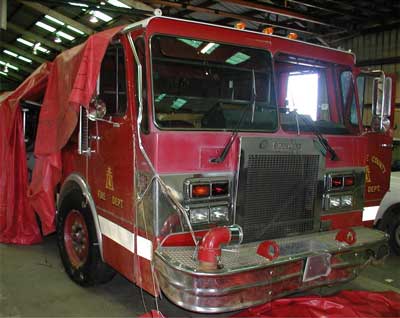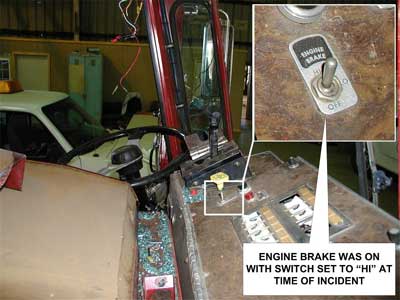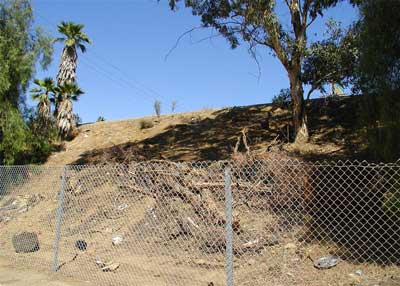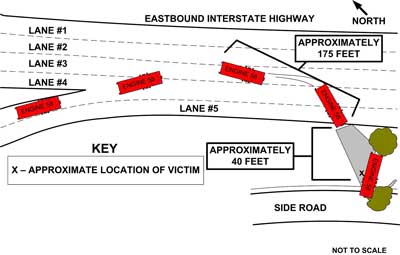

On August 6, 2005, a 23-year-old male career fire fighter (the victim) died after he was ejected from the open cab of an engine during a crash. The crew was responding without lights or sirens to a flooded residence in a reserve engine being used by the crew, while the apparatus they regularly used was being serviced. The engine was traveling at approximately 45 miles per hour in a heavy rainstorm when the driver lost control. The vehicle left the road, traveled down an embankment and struck two trees before coming to rest on a roadway below. The engine’s auxiliary braking system (engine brake) was engaged at the time of the incident. The victim was found lying unresponsive under the running board on the passenger’s side of the vehicle. The victim was found to have lacerations around his mid-section and no pulse. The victim was removed and transported to an area hospital where he was later pronounced dead. The driver/operator and another fire fighter were treated on the scene before being transported to the County hospital for additional treatment.
NIOSH investigators concluded that, to minimize the risk of similar occurrences, fire departments should:
 |
Engine involved in incident |
On August 6, 2005, a 23-year-old male career fire fighter (the victim) died after he was ejected from the open cab of an engine in a crash. The driver/operator and another fire fighter riding in the officer’s seat were injured in the crash. The driver/operator was wearing his station work uniform at the time of the incident. On August 8, 2005, the U.S. Fire Administration notified the National Institute for Occupational Safety and Health (NIOSH) of this incident. On September 27, 2005, a Safety and Occupational Health Specialist from the NIOSH Fire Fighter Fatality Investigation and Prevention Program investigated this incident. A meeting was conducted with the officers assigned by the department to work on this incident. Interviews were conducted with the driver of the apparatus and the fire fighter riding in the officer’s seat. The investigator reviewed incident reports produced by the California Department of Forestry and Fire Protection (CDF) and the California Highway Patrol’s final report on this incident. The NIOSH investigator visited the fire department’s vehicle maintenance shop where he interviewed the shop supervisor regarding the apparatus involved in this incident. The incident site was visited and photographed. The apparatus, which was in storage, was inspected and photographed.
Fire Department
The fire department consisted of 952 career fire fighters and 1,100 volunteer fire fighters in 16 contracta fire stations and 1 fire district that served a population of about 1,600,000 in a geographic area of approximately 7,000 square miles.
Training and Experience
The victim had 2 years of experience with this fire department and was a State certified Fire Fighter Level I. The driver/operator had 3 years of experience as a fire apparatus engineer and 7 additional years experience as a fire fighter with this department. The driver/operator had completed a 132 hour driver/operator course (July 15 - August 2, 2002) provided by the fire department.
Equipment and Personnel
Engine 58 (driver/operator, fire fighter (riding in officer’s seat) and the victim riding in the right rear seat of the open cab. Note: Engine 58 was replaced by reserve Engine
248 due to mechanical problems; the reserve engine is referred to as Engine 58 in this report.
Time line (all times are approximate)
1438 hours – Call from Central Dispatch to fill-in for another station approximately 15 miles to the east.
1452 hours – While en-route to another station, Engine 58 was dispatched to a residential flooding incident.
1455 hours – Driver lost control of apparatus and vehicle traveled over embankment coming to rest on the road below.
1458 hours – Engine 248 fire fighters arrived on the scene after spotting Engine 58 at the bottom of the embankment.
1500 hours – Fire fighter riding in officer’s seat reported incident to Central Dispatch.
1515 hours – Ambulance arrived on the scene and assisted with the removal of the victim.
1529 hours – The victim was transported to the local hospital where he was pronounced dead.
Apparatus
The apparatus involved in this incident was a 1987, 1,000 gallon-per-minute (GPM) engine with an automatic transmission and an auxiliary braking system (engine brake) (Photo 1). The engine’s gross vehicle weight rating was 40,000 pounds (16,000 gross axle weight rating for the front and 24,000 gross axle weight rating for the rear). The engine had two axles with six tires (two in the front and four in the rear) all in good condition. The 500-gallon rectangular-shaped water tank was filled to capacity at the time of the incident. This was an open-cab engine that was equipped to carry six passengers with two front seat positions and four rear-facing seating positions. All six seats had lap belt restraints. The vehicle had passed a safety compliance inspection (required by the state) conducted at an area service station on June 15, 2005 and had traveled approximately 21 miles since the inspection.
The apparatus was a reserve engine that had been placed into service on the day of the incident to replace the engine normally used by this crew which was being serviced. The driver/operator involved in this incident had completed an inspection of this vehicle prior to placing it in service. No defects were found during the inspection.
Road and Weather Conditions
The engine was traveling eastbound on a two-lane blacktop state highway with a posted speed limit of 65 miles per hour (mph). The incident occurred at the interchange where the state highway meets a nine-lane (five lanes eastbound, four lanes westbound) interstate highway (Diagram). The interstate highway has a posted speed limit of 70 mph. The road surface was in good condition and was extremely wet from the sudden heavy rainstorm, but had no standing water.
The weather conditions at the time of the incident included heavy localized rain with a temperature of approximately 77 degrees Fahrenheit with a relative humidity (RH) of 88 percent. The crew first encountered the rain approximately 2 miles west of the incident site.
aCareer and volunteer fire departments under contract with the California Department of Forestry and Fire Protection (CDF) to provide fire protection services, primarily wildland fire suppression
On August 6, 2005, the crew involved in this incident found a mechanical problem (defective brake line) while conducting their daily inspection of the apparatus that they normally used. Unable to fix the problem, the crew placed the engine out of service and obtained a reserve unit. The crew transferred their equipment to the reserve apparatus after conducting an inspection of the apparatus and clearing it for service.
The crew was dispatched at approximately 1438 hours to fill-in for a crew out on a call. At approximately 1452 hours, the crew was traveling eastbound on a two-lane blacktop state highway when they were redirected by Central Dispatch to respond to a flooded residential structure. The crew continued heading eastbound without lights or sirens when the rain changed from a light sprinkle to a heavy downpour as they approached the junction with the interstate highway. The driver/operator reported to the NIOSH investigator that he was traveling at approximately 45 mph as he merged onto lane #3 of the interstate highway (Diagram).
At approximately 1455 hours, the driver/operator eased off of the accelerator pedal as he felt the rear end of the apparatus shift on him. He felt he had regained control of the vehicle when the apparatus began to skid toward the concrete median barrier. The vehicle then turned and headed for the right-hand shoulder of the road. The apparatus traveled approximately 175 feet to the southeast rotating in a clockwise direction while traveling across lanes #3, #4 and #5. The vehicle struck an asphalt concrete drainage dike located on the south edge of the interstate highway. Note: There was no guard rail present on the shoulder of the road (Photo 2). The apparatus continued to rotate in a clockwise direction as it began to travel down the embankment. The rear driver’s side of the vehicle struck a tree causing it to rotate in a counterclockwise direction about its vertical axis while rotating clockwise about its longitudinal axis, exposing the underside of the apparatus. The underside of the apparatus struck a second tree, uprooting the tree and dragging it down the embankment. The State Highway Patrol’s report stated that it was during the longitudinal rotation of the apparatus that the victim was ejected from the right rear seat of the vehicle and was then struck by the vehicle. The vehicle came to rest on its wheels, with the rear wheels on the dirt embankment and the front wheels near the edge of the paved road (Diagram).
The driver/operator was ejected through the front windshield and was able to gather himself and began yelling for the other two fire fighters. The fire fighter riding in the officer’s seat was dazed and confused for what he reported to be approximately 30 seconds. At approximately 1458 hours, Engine 248 was traveling eastbound on the interstate highway when they spotted Engine 58 at the bottom of the embankment. The driver/operator stopped Engine 248 along the shoulder of the highway and backed up to the area where Engine 58 left the roadway.
At approximately 1500 hours, the fire fighter in Engine 58 attempted to radio Central Dispatch on the truck radio but was unsuccessful. He quickly found a portable radio and was able to contact Central Dispatch to report the incident. The fire fighter heard the driver/operating yelling for him and he responded that he was “okay.” He eventually was able to open his door and upon exiting the apparatus he discovered the victim lying unresponsive under the running board on the passenger’s side of the vehicle. The fire fighter also noticed that the driver/operator, standing near the victim, was bleeding from several head wounds. The victim was found to have lacerations around his mid-section and no pulse. Engine 248 fire fighters had climbed down the embankment and assisted the injured Engine 58 driver/operator and the injured fire fighter.
At approximately 1515 hours, an ambulance arrived on the scene and assisted with the removal of the victim. The victim was placed on a backboard before being transported in the ambulance to an area hospital where he was later pronounced dead. The driver/operator and fire fighter were treated at the scene before being transported to the County hospital for additional treatment.
The California Highway Patrol’s accident investigation team reported that the driver/operator and the victim were not wearing their seat belts at the time of the fatal event. The fire fighter riding in the officer’s seat was wearing his seat belt at the time of the incident.
The apparatus involved in this incident was equipped with a secondary braking system (a vehicle-slowing device, not a vehicle-stopping device). The apparatus involved in this incident had a secondary braking system switch inside the cab that allowed the driver to select either a low or high setting. The “low” setting activates three cylinders, yielding approximately 50% braking horsepower. The “high” setting will activate all six cylinders, providing full braking horsepower. The secondary braking system (engine brake) was set on “HI” at the time of the incident (Photo 1). Another driver/operator, who had driven this apparatus numerous times in the past was interviewed by law enforcement. He stated that the apparatus was “tail heavy” and felt that the rear end of the engine had a tendency to “come around” in rainy or wet conditions.
The autopsy report listed the victim’s cause of death as multiple blunt force trauma to the torso
The driver/operator suffered major injuries to his head, torso and right wrist.
The fire fighter riding in the officer’s seat suffered moderate injuries with a contusion to the left side of his head.
Discussion: Fire Departments should ensure that drivers are trained to carefully consider the use of auxiliary braking systems (engine brakes) while driving on wet or potentially slick or slippery roadways. According to the manufacturer’s operators’ manual1, “if the engine brake is new to the operator, it should not be used on slippery roads until some experience is gained on dry pavement.” In addition, the following sequence is provided in the manual as a guideline when driving on wet or icy pavement: “When driving on wet or icy pavement, drivers are to start with the master switch in the “Off” position and use the same gear you would normally use under these conditions. Before activating the engine brake, be sure that you have plenty of distance between your vehicle and other vehicles and that traffic conditions allow for testing or vehicle braking.” Drivers are also advised to “make sure that the vehicle is maintaining traction and stability using the natural retarding or the engine alone.” If the retarding of the engine alone without the engine brake causes a loss of traction, the manual states that the driver should “not attempt to use the engine brake until road conditions improve.” If the vehicle is maintaining traction, the manual states that the driver “may then activate the...”engine brake” by turning the switch to the “Low” position. If the tractor wheels begin to lock or there is a fishtail motion, immediately turn the switch off and don’t turn the “engine brake” on until road conditions improve.” The manual goes on to illustrate that if there was no tendency for the drive wheels to lose traction and the driver desires greater slowing power, the braking switch can be moved to the next highest position. When and if the vehicle experiences a fishtail or the drive wheels lock, the braking switch is to be moved back to the “Low” position.1 In this incident, the braking switch was in the “High” position. According to statements from the driver, he had eased off the accelerator peddle as he felt the rear end of the apparatus shift on him. At this point, with the engine brake on the “High” position, the apparatus began rotating on him as the driver lost control.
Discussion: There is convincing evidence that unfamiliarity with a vehicle increases the crash risk by about a factor of two.2 A fire fighter who is going to drive and operate fire department apparatus must be familiar with all the different types of fire apparatus operated by the department. One method of developing this familiarity is to require the driver to complete a task book3 before taking the driver’s examination. This practice assures the driver is familiar with all of the different models of apparatus that he may encounter. The tasks should meet the minimum requirements for safe driving, and provide a foundation for future learning.3
NFPA 1500 Section 6.2.12: Drivers/Operators of Fire Department Apparatus, states that “The fire department shall include information on the potential hazards of retarders, such as engine, transmission, and driveline retarders, in the driver training program and shall develop written procedures pertaining to the use of such retarders.”4
The driver/operator reported to the NIOSH investigator that he had never operated this vehicle prior to the day of the incident. The engine normally driven by the driver/operator did not have a secondary braking system (engine brake).
The fire department involved in this incident had standard operating procedures (SOPs) requiring the use of seat belts. Fire departments should enforce SOPs on the use of seat belts. The SOPs should apply to all persons riding in all emergency vehicles and state that all persons should be seated and secured in an approved riding position anytime the vehicle is in motion. The driver/operator must always assure the safety of all personnel riding on the apparatus. All riders on the apparatus should be seated within the cab or body and wearing their seat belts before the apparatus is put into motion.5 Seat belts are not only important for protecting occupants in the event of a crash, but may be useful in helping to avoid crashes. The U.S. Fire Administration’s Safe operation of fire tankers states “Some crash reconstruction specialists have speculated that particular incidents may have occurred after the unrestrained driver of a truck was bounced out of an effective driving position following the initial contact with a bump in the road or another object.”6
Discussion: NFPA 1500 Section 6.2.4: Drivers/Operators of Fire Department Apparatus, states that “Drivers of fire apparatus shall be directly responsible for the safe and prudent operation of fire department vehicles.”4 Avoiding conditions that lead to skidding is as important as knowing how to correct skids once they occur. The most common causes of skids include:
• Driving too fast for road conditions
• Failing to properly appreciate weight shifts of heavy apparatus
• Failing to anticipate obstacles (these range from other vehicles to animals)
• Improper use of auxiliary braking devices
• Improper maintenance of tire air pressure and adequate tread depth.5
Weather is another factor to consider in terms of safe driving. Rain, snow, ice, and mud make roads slippery. A driver/operator must recognize these dangers and adjust apparatus speed according to the crown of the road, the sharpness of the curves, and the condition of the road surfaces.5
The Driver/Operator of the vehicle involved in this incident was cited by the Department of California Highway Patrol for operating a vehicle at a speed greater than is reasonable or prudent under adverse weather conditions.7
Engine Brake Operator’s Manual [2006]. www.jakebrake.com/products/docs/Operators-manual.pdf. Date accessed: January, 2007.
This incident was investigated by Mark McFall, Safety and Occupational Health Specialist, Surveillance and Field Investigations Branch (SFIB), Division of Safety Research (DSR), NIOSH. The report was drafted by Mark McFall. The report was finalized and recommendation #1 was written by Robert E. Koedam, Chief, Fatality Investigations Team, SFIB/DSR.
Expert review was provided by Bill Troup, Fire Program Specialist, U.S. Fire Administration and Mike Wieder, Senior Managing Editor, Oklahoma State University, Fire Protection Publications.
 |
 |
 |
Diagram. Aerial view of incident site |
Return to Fire Fighter Homepage
This page was last updated on 06/19/07.